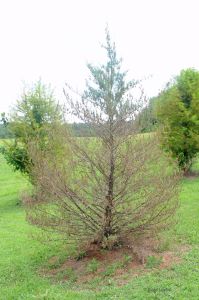Evergreen Bagworm, Vol. 6, No. 7

Thyridopteryx ephemeraeformis
Order: Lepidoptera
Family: Psychidae
If you have needle-bearing evergreen trees or shrubs in your landscape, things like juniper, cedar or Leyland cypress, now is the time to check them carefully for bagworms. Early bagworm infestations are easy to overlook because the bags are small and the needles that are incorporated into the bags are still green, but this is the time they need to be detected and controlled—before they cause serious defoliation. Broad-leafed trees such as oaks can easily recover from being
defoliated by caterpillars, but this is not true for these types of needle-bearing evergreens. Once such trees are defoliated, they are so unsightly and recover so slowly, if they recover at all, that they are often just removed from the landscape. Imagine if this happened to one or two trees someone has planted as a landscape screen or along either side of a driveway. Bagworms do not usually damage pines, but they occur on some broadleaves and sometimes cause serious damage to plantings of Indian hawthorn, which are also slow to recover.
The large, gray-colored bags of mature bagworms are easy to spot, but it is easy to overlook the smaller bags formed by younger caterpillars, and it is important to detect and treat infestations early in the year if you want to prevent serious damage. Evergreen bagworms have only one generation per year. In late summer and fall caterpillars pupate inside their bags and develop into winged males or wingless females. The female moths remain inside their bags, where they mate and lay eggs. The eggs remain inside the bag through the winter and hatch the following spring—about the time crape myrtles are leafing out. Newly hatched caterpillars can be carried by the wind to other nearby trees.
Control: Foliar sprays containing spinosad are the best treatment for bagworms. Fertilome, Green Light, Monterey, and Bonide all sell such products and commercial applicators can use Conserve (Spinosad) or Acelepryn (chlorantraniliprole). Although many other insecticides will kill bagworms, these other products may also trigger a spider mite outbreak, and there are no good “homeowner” treatment for mites. Sprays are most effective when applied in April or May, after eggs have hatched but before caterpillars have caused excessive damage. But if you have larger caterpillars causing damage in June or July they still need to be controlled ASAP. For heavy infestations, make two applications about seven days apart. Sprays applied in late summer or fall after the caterpillars have pupated will not be effective. Hand removal can be useful for small trees with only a few bags and can be done in fall, winter or early spring. The
objective is to remove the bags before the eggs hatch in the spring.
See page 22-23 of Extension Publication 2369, Insect Pests of Ornamental Plants in the Home Landscape, http://extension.msstate.edu/sites/default/files/publications/publications/p2369.pdf for more information.
Blake Layton, Extension Entomology Specialist, Mississippi State University Extension Service.
The information given here is for educational purposes only. Always read and follow current label directions. Specific commercial products are mentioned as examples only and reference to specific products or trade names is made with the understanding that no discrimination is intended to other products that may also be suitable and appropriately labeled.
Mississippi State University is an equal opportunity institution.
- Sign up to receive Bug's Eye View
- Archived Issues
- About this newsletter
